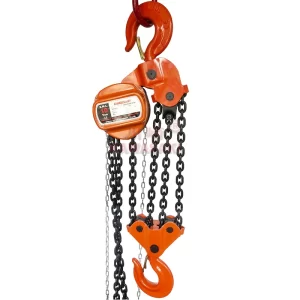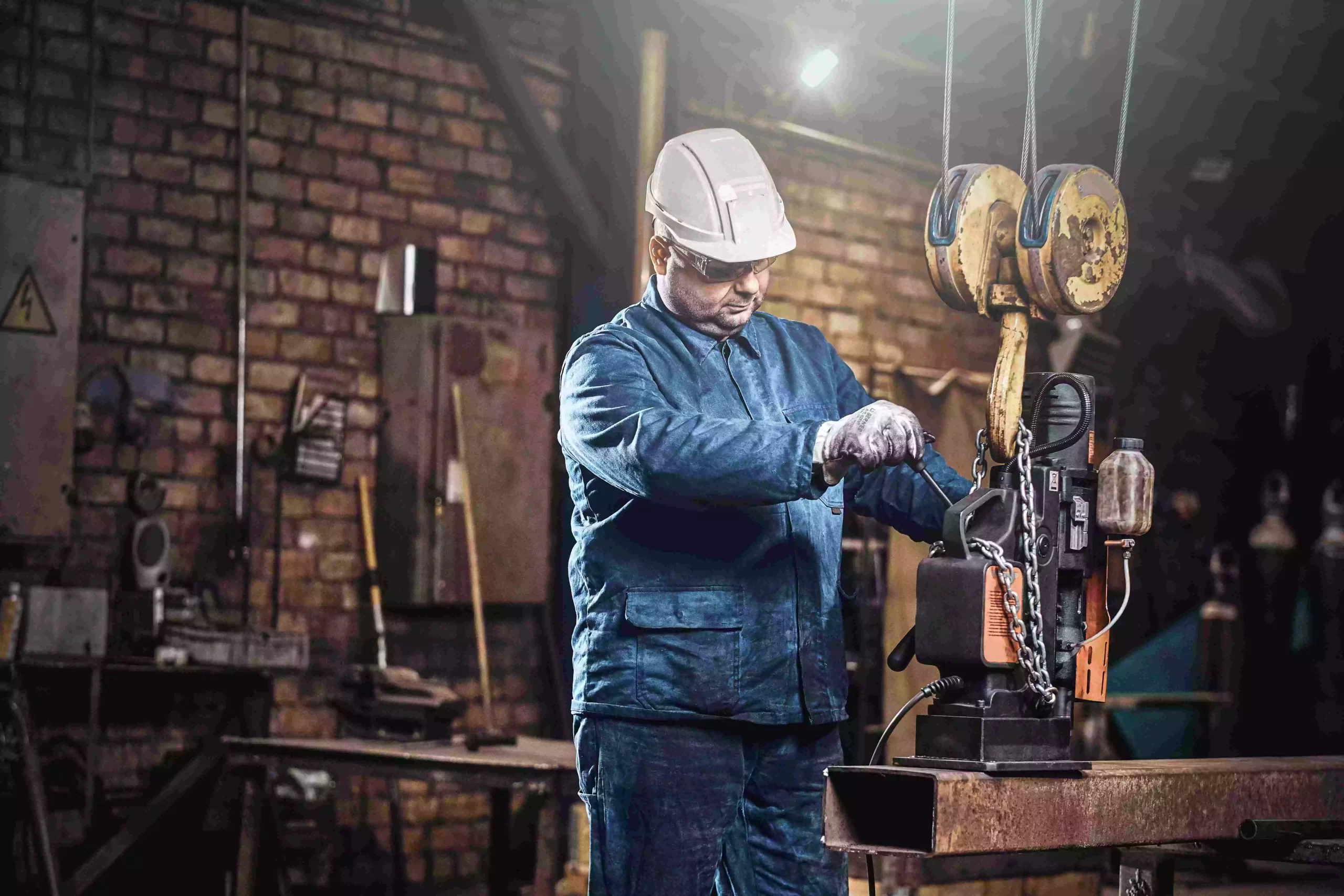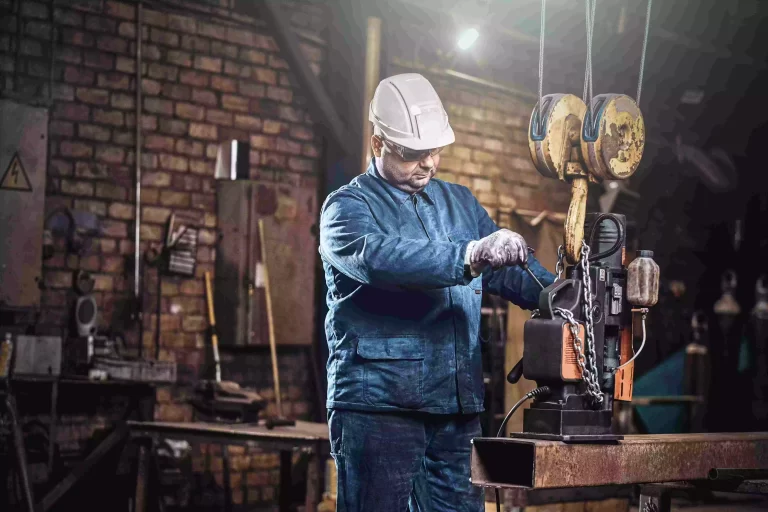Chain hoists are indispensable lifting devices widely used in manufacturing, construction, mining, transportation, and warehousing industries. Their design variations—manual, electric, and pneumatic—each offer distinct advantages and limitations, directly affecting workplace safety and productivity. This article explores how these different chain hoist types influence operations, focusing on their design features, safety mechanisms, and contributions to operational efficiency.
1. Introduction to Chain Hoists
A chain hoist is a mechanical device used to lift or lower heavy loads using a chain. These devices operate through a lifting mechanism comprising a pulley system, gear transmission, and braking elements. Depending on the power source and application, chain hoists are typically classified into:
- Manual Chain Hoists (Hand Chain Blocks)
- Electric Chain Hoists
- Pneumatic Chain Hoists (Air Hoists)
Each of these designs serves specific operational needs and environmental conditions. Understanding their structural differences and functional impacts is crucial for improving both safety standards and productivity in industrial settings.
2. Manual Chain Hoists: Safety and Productivity Profile
Design and Operation:
Manual chain hoists rely on human power to operate. The operator pulls a hand chain, which rotates gears inside the hoist, gradually lifting the load through mechanical advantage.
Safety Impact:
- Control and Precision: Because manual hoists operate slowly and require constant human control, operators maintain direct contact with the load. This can reduce the risk of sudden, uncontrolled movements but increases ergonomic stress.
- No Electrical Hazard: Manual hoists are safe in flammable or explosive environments since they do not require electricity or generate sparks.
- Risk of Overload: Without built-in overload protection mechanisms (unless added), there is a potential for lifting loads beyond the device’s rated capacity, leading to equipment failure and injuries.
Productivity Impact:
- Labor Intensive: The speed of lifting is limited by human strength, making these hoists less efficient for frequent or heavy-duty lifting.
- Low Maintenance: They require minimal maintenance and are ideal for light to moderate, infrequent lifting tasks.
- Portable and Cost-Effective: Their lightweight design makes them portable, and they are cost-effective for small operations or maintenance tasks.
Common Applications:
- Workshops
- Construction sites (especially remote areas)
- Maintenance departments
3. Electric Chain Hoists: Safety and Productivity Profile
Design and Operation:
Electric chain hoists are powered by electric motors and controlled via pendant or remote switches. These are commonly mounted on overhead rails, gantry cranes, or trolleys to enhance load mobility.
Safety Impact:
- Overload Protection: Modern electric hoists are equipped with overload limiters, emergency stop functions, and thermal protection for motors, minimizing the risk of accidents.
- Consistent Speed and Movement: They offer smooth and controlled lifting, reducing jerking or load swing, which is critical in tight or hazardous environments.
- Reduced Human Strain: Since lifting is automated, operator fatigue is reduced, minimizing the risk of human error due to physical exhaustion.
Productivity Impact:
- High Lifting Speed: Electric hoists are significantly faster than manual versions, boosting throughput in production lines or warehouses.
- Remote Operation: Remote controls allow operators to maintain a safe distance from the load, improving both safety and speed of operation.
- Programmability: Advanced models offer programmable lifting cycles and synchronized movements, enhancing precision and repeatability in automated environments.
Common Applications:
- Manufacturing assembly lines
- Warehousing and logistics
- Vehicle maintenance facilities
4. Pneumatic Chain Hoists: Safety and Productivity Profile
Design and Operation:
Pneumatic hoists operate on compressed air and are ideal for environments where electricity is either unavailable or hazardous. They offer variable speed control and can be used continuously without overheating.
Safety Impact:
- Explosion-Proof Operation: These hoists are inherently safe in environments with flammable gases, vapors, or dust—such as chemical plants or oil refineries—since they don’t produce sparks.
- Durability in Harsh Conditions: They are less affected by temperature extremes, moisture, or corrosive environments, maintaining operational integrity where electric hoists may fail.
- Reduced Electromagnetic Interference: Air hoists don’t interfere with sensitive equipment, making them suitable for medical and precision manufacturing settings.
Productivity Impact:
- Continuous Operation: Pneumatic motors can run continuously without overheating, making them ideal for high-cycle or long-shift operations.
- Fast and Responsive Control: Operators benefit from precise speed and load control, enabling high-accuracy placement of materials.
- Infrastructure Dependency: They require a reliable compressed air supply, which can be a limitation in remote or mobile applications.
Common Applications:
- Oil and gas industry
- Marine and shipbuilding sectors
- Underground mining
- Paint shops and explosive environments
5. Comparative Summary: Safety and Productivity Trade-offs
| Feature | Manual Hoists | Electric Hoists | Pneumatic Hoists |
|---|---|---|---|
| Power Source | Human | Electricity | Compressed Air |
| Safety in Explosive Environments | High | Low | Very High |
| Operator Fatigue | High | Low | Low |
| Lifting Speed | Slow | Fast | Fast |
| Maintenance Needs | Low | Moderate | High |
| Ideal Application Frequency | Infrequent | Frequent | Continuous |
| Environmental Resistance | Moderate | Low (unless sealed) | High |
| Cost | Low | Medium to High | High (with infrastructure) |
6. Industry-Specific Impacts
Construction Industry:
- Manual hoists are often used due to their portability, especially in locations where power isn’t readily available.
- Electric hoists speed up material handling in scaffolding and prefab assembly.
- Pneumatic hoists are rarely used unless working in confined spaces with explosion risks.
Manufacturing and Warehousing:
- Electric hoists dominate due to their automation capabilities and integration with production lines.
- They enhance safety by reducing manual handling injuries and increasing throughput.
- Manual hoists are kept as backup or for low-frequency tasks.
Oil, Gas, and Chemical Industries:
- Pneumatic hoists are essential due to strict explosion-proof requirements.
- Their ability to operate continuously and safely in hazardous areas makes them irreplaceable in this sector.
Mining:
- Pneumatic hoists are favored underground due to low spark risk and tolerance for dirty, damp conditions.
- Safety is further enhanced by their durability and resistance to dust and gases.
7. Safety Enhancements Across Designs
No matter the type, the following features can further enhance hoist safety:
- Load Limiters – Prevent the hoist from lifting beyond rated capacity.
- Emergency Brakes – Instantly stop motion during failure or power cut.
- Anti-Drop Mechanisms – Prevent unintentional load release.
- Chain Containers – Keep slack chains from creating trip hazards.
- Ergonomic Controls – Reduce physical strain and enhance precision.
Training and routine inspections also play a crucial role in mitigating risk, regardless of hoist design.
8. Choosing the Right Hoist for Optimal Safety and Productivity
Selecting the appropriate hoist type must be based on:
- Load weight and lifting frequency
- Power availability
- Work environment (explosive, humid, outdoor, etc.)
- Desired automation level
- Budget constraints
A mismatch in hoist type and application can compromise both safety and efficiency, underscoring the importance of proper assessment during procurement.
9. Conclusion
The impact of chain hoist design on workplace safety and productivity is significant and multifaceted. Manual hoists offer affordability and simplicity, best suited for low-intensity tasks. Electric hoists balance speed and automation with advanced safety features, ideal for repetitive industrial lifting. Pneumatic hoists stand out in hazardous environments with their spark-free operation and durability.
Understanding these distinctions empowers industry professionals to make informed decisions that safeguard workers while optimizing operational output. As industries continue to pursue higher safety standards and leaner workflows, the right chain hoist design is not merely a tool—but a strategic asset.


